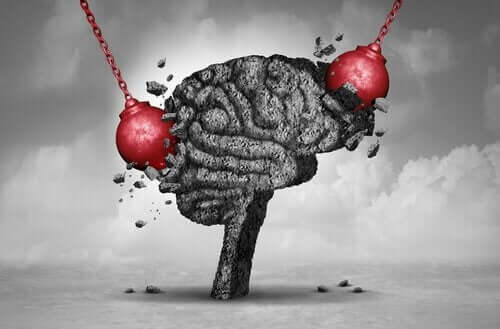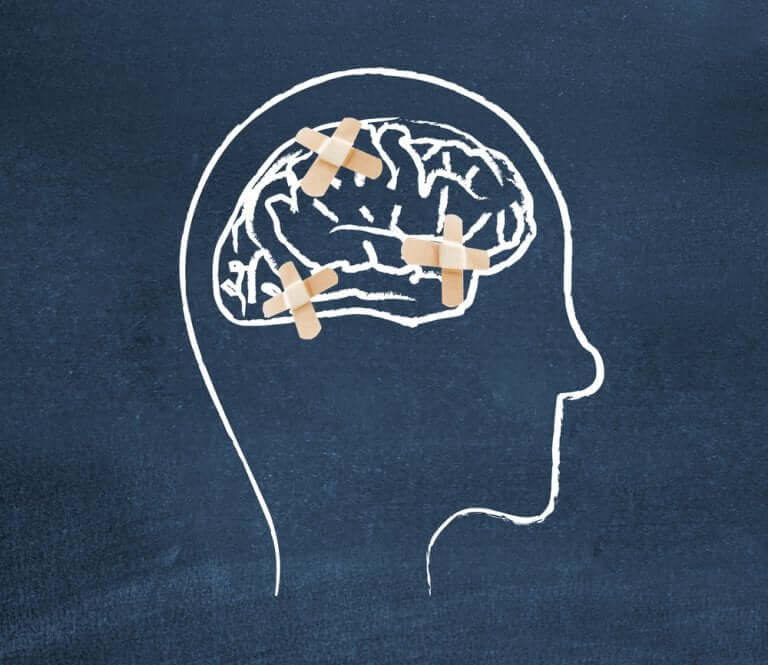What Is Acquired Brain Injury in Children?

Acquired brain injury is a brain injury that occurs after birth. It produces a permanent or temporary deficit, of a physical, psychic, cognitive, behavioral, sensory, emotional or social nature. As a result, it reduces the child’s functional capacity and quality of life.
It occurs after an injury to brain structures that disrupts the normal development of the child’s brain. Acquired brain injury can be caused by an accident or fall, lack of oxygen to the brain, brain tumors, a stroke, encephalopathy, refractory epilepsy, radiation therapy to the nervous system, and infectious diseases.
When a child has had a brain injury, the consequences may be delayed until the brain development for the affected ability is complete. Although at first it may seem that the child hasn’t been affected, after a while certain difficulties become apparent. This can create confusion and misunderstanding in the family circle and at school.
Experts recommend that the child with acquired brain injury be cared for by a multidisciplinary team in order to receive a proper rehabilitation. To provide comprehensive care, the following experts should take part in the child’s rehabilitation:
- Neuropediatricians
- Rehabilitation physicians
- Neuropsychologists
- Clinical psychologists
- Physical therapists
- Psychomotor therapists
- Speech therapists
- Occupational therapists
- Child psychiatrists
What are the consequences of acquired brain injury in children?
It should be noted that the consequences of the brain injury depend on the area of the brain that has been affected, the severity of the injury, and the age at which it occurs. Some of the major consequences of acquired brain injury are:
Physical and sensory consequences
These affect the child’s mobility, activity and safety. You can compensate for this with adaptations and support products.
Cognitive consequences
Children with acquired brain injury have a combination of motor, cognitive and behavioral problems, which must be treated in a specific way.
Consequences in communication
If the injury occurs in the dominant lateral hemisphere, then it’s usually on the left side. It’s common for this to affect communication and the ability to understand and express oneself through oral language.
This can then lead to aphasia and dyslexia. They may have difficulty in naming everyday objects, causing anomie. In other children, it may affect their voice, causing dysphonia.
Consequences in judgment and decision making
The child will often experience problems with their executive functions, as they directly influence the ability to make decisions. The child may have difficulties trying to start activities, and also doubts and inappropriate or ineffective responses to certain situations.

Emotional and behavioral consequences
A child with an acquired brain injury can start to behave in an inappropriate way, both at school and outside of school. Behavioral changes may become apparent months or years after the injury, and these directly relate to the nature of the injury and its evolution.
The most frequent manifestations are:
- Low tolerance to frustration
- Disproportionate anger
- Aggressiveness
- Sudden mood swings
- Inhibition
- Inappropriate comments
- Isolation
What can be done to reduce the consequences of childhood acquired brain injury?
Fatigue
If the child is tired, then it’s best to schedule activities gradually and set frequent rest intervals.
Limitations on memory
If a child has memory limitations, then it’s advisable to make some sort of notebook where they can record their daily activities and reminders, as well as using alarms. In addition to this, you should help them to use items such as blackboards, calculators, tablets, mobile phones, and computers to help them to remember important information.
Use helpful tools to promote autonomy when carrying out tasks, such as sticky notes, color-coding by subject, and diagrams. It’s also good to use tests or quizzes (whenever possible) so that the child can learn to recognize and choose the correct information. Finally, it’s very important for them to learn to relate new information to information they’ve just learned.
Limitations of attention
If the child has attention deficit, then it’s important to propose only one task at a time to avoid an overload of information. You should remove unnecessary distractions from their work area, so that the child is able to fully listen and carry out the task at hand.
It’s also important to introduce new information gradually, and not to bring sudden changes to the activity. In addition to this, you should clearly praise them when they’ve made progress in a certain area, and do it right after they’ve said or done something correctly.
Limitations in communication
If the child’s limitations relate to communication, then it’s essential to use short and clear instructions. Encourage them to participate in the conversation, and give them time to assimilate and respond to what you’ve told them.
Speak slowly, and accompany verbal instructions with written ones. As well as this, you should facilitate the use of tools that support communication, such as recorders, computers, or tablets. Reducing background noise and avoiding the use of plays on words or jokes is also very beneficial.

Limitations in decision making
With regard to limitations in decision-making, you should establish a plan or routine that stipulates the daily tasks, in order to help the child feel secure. You can also help them to identify problematic situations in the classroom and in family situations, and look for alternative solutions.
One important point is that you should prepare the child in advance for any changes in routine that may arise in the classroom or in the family. It’s a good idea to provide diagrams to help the child to get organized. When they’re feeling unsure, then remind them of some pre-established rule to help them stop and think about the situation.
Behavioral limitations
To reduce these kinds of limitations, it’s advisable to set clear limits, avoid confrontations when they behave inappropriately, and divert the child’s attention to something else that may be of interest to them.
You should also give alternatives to inappropriate behavior. Make suitable changes in their surroundings to try to avoid this inappropriate behavior, and reward their good behavior so that they get used to doing it, and want to do it. If the child seems a bit overemotional, then it’s best not to show undue concern.
These are some guidelines for you on how to interpret and deal with different behavior and attitudes that can occur as a result of acquired brain injury in childhood, and we hope they’ll be helpful to you.
Acquired brain injury is a brain injury that occurs after birth. It produces a permanent or temporary deficit, of a physical, psychic, cognitive, behavioral, sensory, emotional or social nature. As a result, it reduces the child’s functional capacity and quality of life.
It occurs after an injury to brain structures that disrupts the normal development of the child’s brain. Acquired brain injury can be caused by an accident or fall, lack of oxygen to the brain, brain tumors, a stroke, encephalopathy, refractory epilepsy, radiation therapy to the nervous system, and infectious diseases.
When a child has had a brain injury, the consequences may be delayed until the brain development for the affected ability is complete. Although at first it may seem that the child hasn’t been affected, after a while certain difficulties become apparent. This can create confusion and misunderstanding in the family circle and at school.
Experts recommend that the child with acquired brain injury be cared for by a multidisciplinary team in order to receive a proper rehabilitation. To provide comprehensive care, the following experts should take part in the child’s rehabilitation:
- Neuropediatricians
- Rehabilitation physicians
- Neuropsychologists
- Clinical psychologists
- Physical therapists
- Psychomotor therapists
- Speech therapists
- Occupational therapists
- Child psychiatrists
What are the consequences of acquired brain injury in children?
It should be noted that the consequences of the brain injury depend on the area of the brain that has been affected, the severity of the injury, and the age at which it occurs. Some of the major consequences of acquired brain injury are:
Physical and sensory consequences
These affect the child’s mobility, activity and safety. You can compensate for this with adaptations and support products.
Cognitive consequences
Children with acquired brain injury have a combination of motor, cognitive and behavioral problems, which must be treated in a specific way.
Consequences in communication
If the injury occurs in the dominant lateral hemisphere, then it’s usually on the left side. It’s common for this to affect communication and the ability to understand and express oneself through oral language.
This can then lead to aphasia and dyslexia. They may have difficulty in naming everyday objects, causing anomie. In other children, it may affect their voice, causing dysphonia.
Consequences in judgment and decision making
The child will often experience problems with their executive functions, as they directly influence the ability to make decisions. The child may have difficulties trying to start activities, and also doubts and inappropriate or ineffective responses to certain situations.

Emotional and behavioral consequences
A child with an acquired brain injury can start to behave in an inappropriate way, both at school and outside of school. Behavioral changes may become apparent months or years after the injury, and these directly relate to the nature of the injury and its evolution.
The most frequent manifestations are:
- Low tolerance to frustration
- Disproportionate anger
- Aggressiveness
- Sudden mood swings
- Inhibition
- Inappropriate comments
- Isolation
What can be done to reduce the consequences of childhood acquired brain injury?
Fatigue
If the child is tired, then it’s best to schedule activities gradually and set frequent rest intervals.
Limitations on memory
If a child has memory limitations, then it’s advisable to make some sort of notebook where they can record their daily activities and reminders, as well as using alarms. In addition to this, you should help them to use items such as blackboards, calculators, tablets, mobile phones, and computers to help them to remember important information.
Use helpful tools to promote autonomy when carrying out tasks, such as sticky notes, color-coding by subject, and diagrams. It’s also good to use tests or quizzes (whenever possible) so that the child can learn to recognize and choose the correct information. Finally, it’s very important for them to learn to relate new information to information they’ve just learned.
Limitations of attention
If the child has attention deficit, then it’s important to propose only one task at a time to avoid an overload of information. You should remove unnecessary distractions from their work area, so that the child is able to fully listen and carry out the task at hand.
It’s also important to introduce new information gradually, and not to bring sudden changes to the activity. In addition to this, you should clearly praise them when they’ve made progress in a certain area, and do it right after they’ve said or done something correctly.
Limitations in communication
If the child’s limitations relate to communication, then it’s essential to use short and clear instructions. Encourage them to participate in the conversation, and give them time to assimilate and respond to what you’ve told them.
Speak slowly, and accompany verbal instructions with written ones. As well as this, you should facilitate the use of tools that support communication, such as recorders, computers, or tablets. Reducing background noise and avoiding the use of plays on words or jokes is also very beneficial.

Limitations in decision making
With regard to limitations in decision-making, you should establish a plan or routine that stipulates the daily tasks, in order to help the child feel secure. You can also help them to identify problematic situations in the classroom and in family situations, and look for alternative solutions.
One important point is that you should prepare the child in advance for any changes in routine that may arise in the classroom or in the family. It’s a good idea to provide diagrams to help the child to get organized. When they’re feeling unsure, then remind them of some pre-established rule to help them stop and think about the situation.
Behavioral limitations
To reduce these kinds of limitations, it’s advisable to set clear limits, avoid confrontations when they behave inappropriately, and divert the child’s attention to something else that may be of interest to them.
You should also give alternatives to inappropriate behavior. Make suitable changes in their surroundings to try to avoid this inappropriate behavior, and reward their good behavior so that they get used to doing it, and want to do it. If the child seems a bit overemotional, then it’s best not to show undue concern.
These are some guidelines for you on how to interpret and deal with different behavior and attitudes that can occur as a result of acquired brain injury in childhood, and we hope they’ll be helpful to you.
All cited sources were thoroughly reviewed by our team to ensure their quality, reliability, currency, and validity. The bibliography of this article was considered reliable and of academic or scientific accuracy.
- FEDACE. (2008) Daño cerebral adquirido infantil. Madrid; Octubre 2008; 234 págs https://www.sarela.org/userfiles/files/7_DCA_infantil-ilovepdf-compressed.pdf
- Rodríguez Boggia, Daniel Daño cerebral adquirido. (DCA). Logopeda y Psicopedagogo; 6 págs. http://www.sld.cu/galerias/pdf/sitios/rehabilitacion-logo/dano_cerebral-09.pdf
This text is provided for informational purposes only and does not replace consultation with a professional. If in doubt, consult your specialist.








